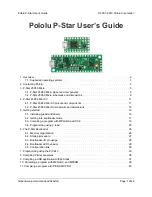
supply (such as a battery or wall power adapter) to the VIN and GND pins, with the positive terminal
connected to VIN.
VDD:
This pin provides access to the board’s 5 V supply, which comes from either the USB 5 V bus
voltage or a low-dropout (LDO) regulator on VIN, depending on which power source is connected. The
regulator can supply up to 100 mA, although some of this is used by the board itself or used to provide
current for the GPIO pins.
To ensure that VDD is a stable 5 V, you must either disconnect VIN and use USB to power the board or
supply a VIN of at least 5.5 V. When VIN drops below 5.5 V, VDD will fall (even with USB connected).
However, the P-Star will continue to run with VDD below 5 V, and it can operate from VIN alone with
VIN as low as 3.2 V to 3.8 V, depending on the load and temperature. With USB connected, VDD will
drop at worst to about 4.5 V, and the P-star will continue operating no matter how low VIN is.
When the P-Star 25K50 Micro is being powered through VIN, regardless of whether USB is connected,
the sum of the 5V output current, GPIO output current, and current used by the board itself (typically
about 18 mA) should not exceed the 100 mA that the regulator can provide.
P-Star 25K50 Micro, bottom view.
P-Star 25K50 with U.S. quarter for size
reference.
USB power sensing
The VB pin, located on the interior of the board, is connected to the USB 5 V bus voltage through a
1 kΩ resistor. By default, the VB pin is also connected to the RA0 pin through a cuttable trace on the
bottom of the board between the two pins. This means that RA0 can be used as a digital or analog
input to detect the presence of USB power. Cutting the trace between the VB and RA0 pins allows
RA0 to be used for other purposes.
Crystal
The P-Star 25K50 Micro has a precision 16 MHz crystal. By default, this crystal is used to provide a
clock signal for the microcontroller and its peripherals.
Pololu P-Star User’s Guide
© 2001–2019 Pololu Corporation
3. P-Star 25K50 Micro
Page 7 of 46






















